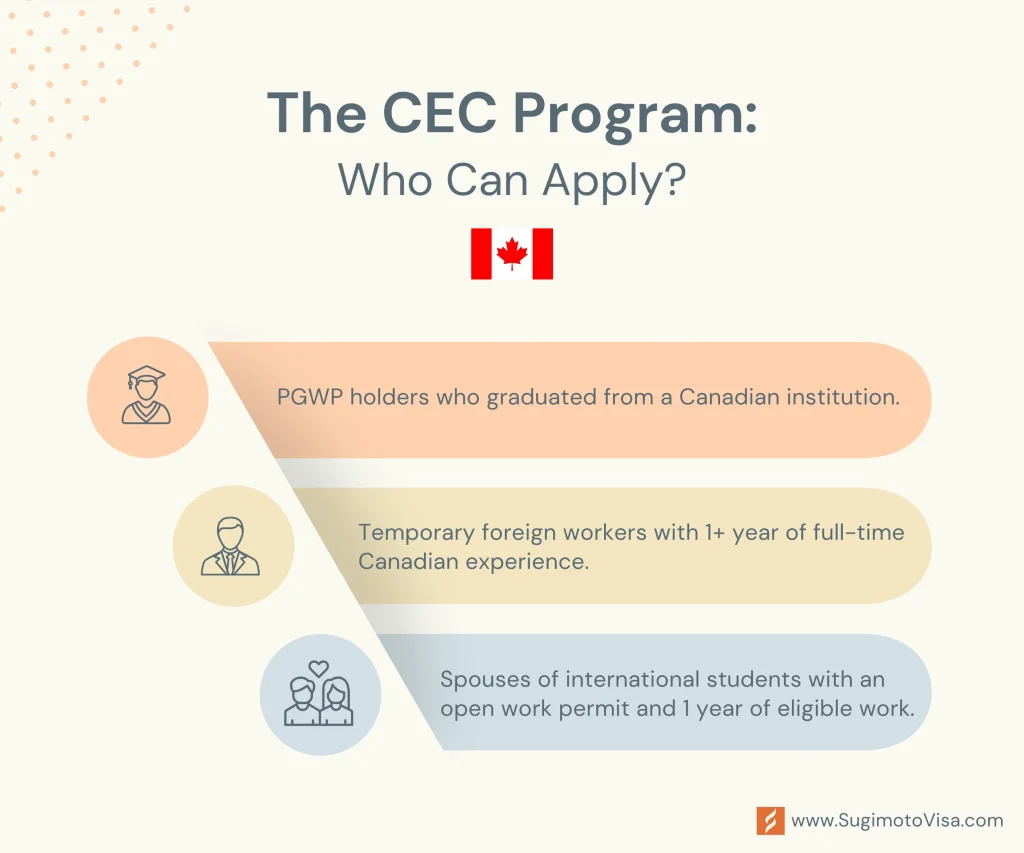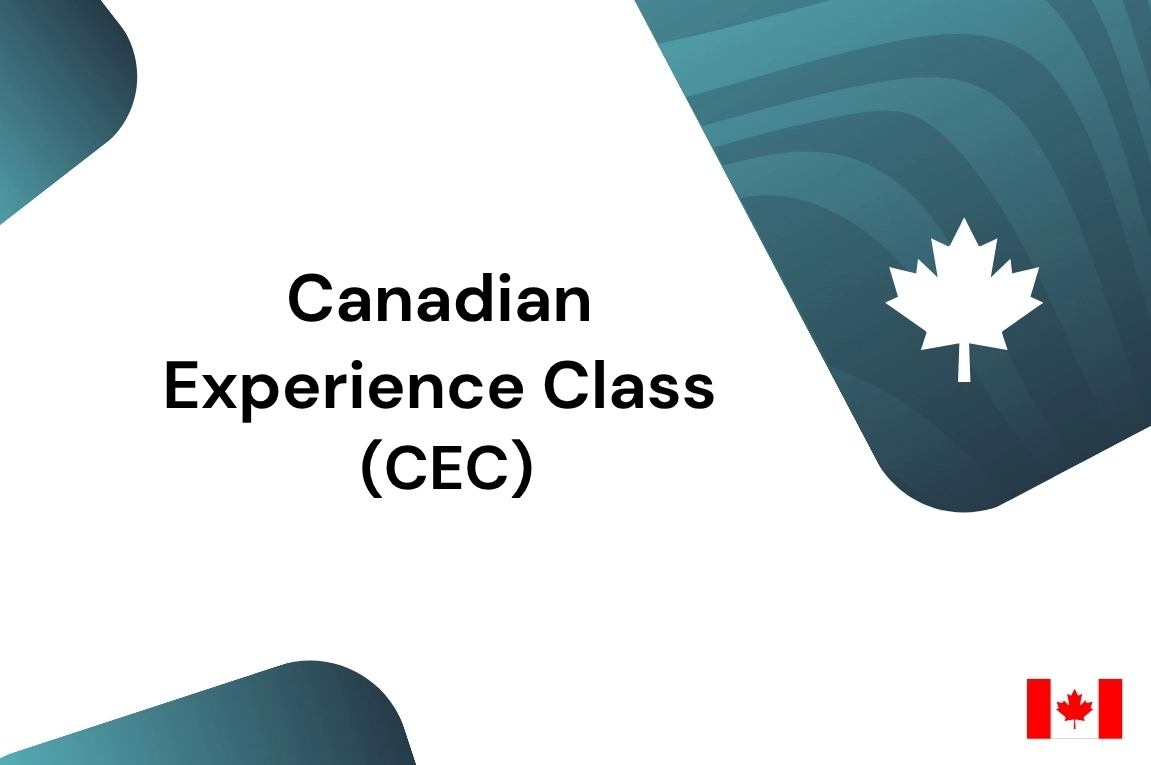If you’ve already lived, studied, or worked in Canada and are thinking, “How can I make this beautiful country my forever home?” the Canadian Experience Class (CEC) might just be your answer.
This program is part of Canada’s Express Entry system and is designed especially for people who’ve proven they can thrive in Canada. Maybe you’ve graduated from a Canadian school, worked here for a while, or even supported a partner who’s studying, if that sounds like you, you’re in the right place.
Let’s break things down simply and clearly so you can understand your options and take your next steps with confidence.
Snapshot
- Program name: Canadian Experience Class (CEC); Express Entry
- Who can apply:
- Skilled workers with 12 months (1,560 hours) of paid Canadian work experience in the last 3 years
- International graduates on a PGWP once completed 12 months of paid work
- Eligibility:
- Language: CLB 7 (TEER 0–1) or CLB 5 (TEER 2–3)
- Education or Work experience in Canada
- Medical exam
- Fees: IRCC economic immigration (incl. CEC): $950 processing + $575 RPRF = $1,525 per adult; $260 per dependent child; biometrics $85/person or $170/family
- CRS score: Varies by draw; no fixed pass mark. In 2025, CEC cut-offs have ranged roughly ~518–547
What Is the Canadian Experience Class (CEC)
The CEC is one of the most direct and efficient routes to permanent residency (PR) in Canada. It’s designed for people with at least one year of skilled work experience in Canada within the past three years.
Think of it as Canada’s way of saying: “You’ve already proven yourself , let’s make it official.”
And here’s what makes it especially attractive:
- No need for a job offer
- No educational credential assessment (ECA) required
- Just real Canadian work experience, backed by valid documents
Who Can Apply?
CEC is tailored for people like:
- International graduates with a Post-Graduation Work Permit (PGWP)
- Temporary foreign workers with at least one year of full-time Canadian experience
- Spouses of international students who got an open work permit and completed one year of eligible work
If you’ve worked legally in Canada for a year, full-time or the equivalent in part-time, you might be ready to apply.
Main Benefits of CEC
- Fast processing (typically around 6 months)
- No job offer required (though it can boost your score)
- No settlement funds needed if you’re already working here
- Freedom to live anywhere in Canada (except Quebec)
- Entirely online application process
- Lower overall costs than many other immigration pathways
If you’re someone who’s already adapted to Canadian life, this program rewards that effort with a smoother, faster path to residency.

Eligibility Criteria
Let’s take a closer look at what you’ll need to qualify.
1. Skilled Work Experience in Canada
Your work must have been done in Canada with valid authorization. If it was “remote,” you still had to be physically in Canada and working for a Canadian employer. You can count up to 30 hours per week toward your total. Anything above 30 hours a week doesn’t add extra hours.
Self-employment and work done while you were a student (including co-op cources) do not count. There’s a temporary, narrow exception for some physicians, which must be clearly identified.
- Duration: At least 1 year (1,560 hours) in the last 3 years
- Job type: Must fall under TEER 0, 1, 2, or 3 of Canada’s NOC (National Occupation Classification)
- Job format: Can be full-time or part-time, but not self-employed
Quick Tip: TEER 0–3 jobs include managers, professionals (like engineers), technicians, tradespeople, and more.
❌ Did you work while you were still a student? Unfortunately, that experience doesn’t count. You need to gain work experience after graduation with a valid work permit.
2. Language Proficiency
You’ll need to prove your ability in English or French with one of the accepted tests:
- For TEER 0 and 1 jobs: CLB 7 (moderate proficiency)
- For TEER 2 and 3 jobs: CLB 5 (basic to intermediate proficiency)
Accepted Tests:
- English: CELPIP (General) or IELTS (General Training)
- French: TEF Canada or TCF Canada
How do your test scores convert to CLB levels? There are official conversion tables, and we can help walk you through them.
👤 Raja’s Story
Take Raj, a software developer from India. After a year of working in Toronto, he applied through CEC and got his PR within six months, without hiring a job agency or leaving the country.
👉🏻 If your situation sounds similar, go ahead and fill out the assessment form, one of our experts will be in touch to guide you through the next steps.
CEC Draws Through Express Entry
IRCC has been running program-specific rounds for Canadian Experience Class (CEC) alongside category-based and PNP draws. In 2025, CEC-only rounds have appeared regularly (about one per month since August) with recent cut-offs holding at CRS 534. Earlier in the year the range stretched from 547 (May 13) down to 518 (July 8). Data below is compiled from CIC News’ 2025 draw summaries.
Canadian Experience Class (CEC) latest draws information:
| Date | Number of invitations issued | CRS score of lowest-ranked candidate invited |
|---|---|---|
| Oct 1, 2025 | 1,000 | 534 |
| Sep 3, 2025 | 1,000 | 534 |
| Aug 7,2025 | 1,000 | 534 |
| Jul 8, 2025 | 3,000 | 518 |
| Jun 26, 2025 | 3,000 | 521 |
| Jun 12, 2025 | 3,000 | 529 |
| May 13, 2025 | 500 | 547 |
| Feb 5, 2025 | 4,000 | 521 |
| Jan 23, 2025 | 4,000 | 527 |
| Jan 8, 2025 | 1,350 | 542 |
CRS Score (Comprehensive Ranking System)
You’ll be ranked against other Express Entry applicants based on factors like:
- Age
- Language skills
- Canadian work experience
- Education (if applicable)
- Job offers (optional)
- Spouse’s profile (if applicable)
There isn’t a permanent minimum CRS for the Canadian Experience Class (CEC). In each draw, IRCC invites the top-ranked eligible profiles and the cut-off becomes the CRS of the lowest-ranked candidate invited in that round.
In a CEC-only draw, IRCC ranks CEC-eligible candidates against each other. That’s why CEC cut-offs can differ from general or category-based draws.
reported CEC-only rounds in 2025 show cut-offs from 547 (May 13) down to 518 (July 8), with several later CEC draws sitting at 534 (Aug 7, Sep 3, Oct 1).
Document Checklist for CEC
- Valid Passport
- Photo
- Language test: IELTS General, CELPIP General, PTE Core, TEF Canada, or TCF Canada (must be <2 years old)
- Canadian work experience:
- Employer reference letters on letterhead for each job claimed: titles, duties, dates, hours/week, salary, supervisor’s name/title/signature + contact info.
- Supporting proof: recent pay stubs, T4/NOA (if available), contracts/ROE.
- Copies of your valid work permit(s) (e.g., PGWP), entry stamps/visas or eTAs showing you were authorized to work in Canada while gaining CEC experience
- Education
- Canadian credentials (if any) or ECA report
- Police certificates
- Medical exam
- Certified translations (in English or French)
Latest Updates and News
🚨 CETA Professional and the CEC pathway: Self-employment does not count for the CEC
According to an internal IRCC response, individuals who, under a “CETA Professional” work permit, are effectively considered self-employed are generally not eligible for the Canadian Experience Class (CEC), because the law does not count self-employment as qualifying work experience for the CEC. There is a limited exception for physicians (under a temporary 2023 policy), but the general rule still applies.
How to Apply Through CEC (Step-by-Step)
Let’s simplify the process. Here’s what your journey might look like:
Step 1: Get a Legal Canadian Work Permit
Start with either:
- An open work permit (for spouses of students or eligible foreign workers), or
- A closed/employer-specific permit (with or without LMIA)
Step 2: Complete One Year of Skilled Work
You need 12 months of full-time or 24 months of part-time work experience in a qualifying job. This can be with one or multiple employers.
Step 3: Take a Language Test
Register and complete a language test. You must meet the minimum CLB score based on your TEER level.
Step 4: Create Your Express Entry Profile
Head over to Canada’s official immigration website and build your profile. You’ll need:
- Language test results
- Work experience details
- Passport or ID
- ECA (only if your education is from outside Canada)
Step 5: Improve Your CRS Score (Optional but Smart!)
Want to stand out? Consider:
- Retaking your language test
- Gaining more work experience
- Getting a job offer
- Including your spouse’s details
Step 6: Receive an ITA (Invitation to Apply)
If your profile is selected, you’ll get an invitation to submit your PR application. Congrats!
Step 7: Submit Your Application
You’ll have 60 days to upload documents and pay fees:
- Application fee: CAD $850 (adults), $230 (kids)
- Right of PR fee: CAD $515 (adults)
- Biometrics: CAD $85 per person or $170 per family
Step 8: Get Your AOR (Acknowledgement of Receipt)
This confirms your application was received by IRCC.
Step 9: Biometrics, Background Checks, and Review
You may be asked to submit biometrics or additional documents. This phase takes around 5–6 months.
Step 10: Receive Your COPR and Visa
If approved, you’ll get:
- COPR (Confirmation of Permanent Residence)
- Passport Request Letter (PPR)
Step 11: Land in Canada
Once your visa is issued, you must enter Canada before the expiry date. Upon landing, you become a Canadian permanent resident!
🚨 Upfront medical exam now required (Effective August 21, 2025)
If you’re applying for permanent residence through Express Entry, you must complete an upfront Immigration Medical Exam (IME) before you submit your PR application. Update your steps so “Medical exam (upfront)” appears before “Upload documents / Pay fees / Submit application.”
Official source: IRCC – When to get your medical exam
Common Reasons for Rejection (and How to Avoid Them)
Unfortunately, not every application goes smoothly. Here are some common pitfalls:
- Expired or missing language test results
- Work experience that doesn’t meet TEER/NOC requirements
- Incomplete or incorrect documents
- A low CRS score
- Inadmissibility issues (criminal record, medical)
How can you protect your application? Double-check everything before you submit. And when in doubt, get help. Immigration professionals can spot issues before they become deal-breakers.
Final Thoughts: Is the CEC Right for You?
If you’ve already worked in Canada, the Canadian Experience Class offers one of the most straightforward, affordable, and fast-tracked routes to permanent residency.
It’s not just a program, it’s recognition of your effort, your contribution, and your potential.
So, if you’re ready to make Canada your forever home, why not take the next step?
Need help figuring out your eligibility or next move? We’re here for you; reach out today for a free consultation and let’s explore your future together.
FAQs
Yes! As long as you meet the work experience and documentation requirements, you can apply even if you’ve returned home.
Nope. It’s not required, though it can help boost your CRS score.
Usually, about 6 months from the date you submit your PR application.
Absolutely. Both English and French are official languages, and either can be used for your language test.
It must be valid when you submit your profile and when you receive an ITA. Plan ahead to avoid delays.
Yes, as long as it adds up to 1,560 hours over a 3-year period.
Jobs under TEER 0, 1, 2, or 3 of the NOC system qualify. These include professional, technical, and skilled trades roles.
Yes, your application can include eligible dependents.


